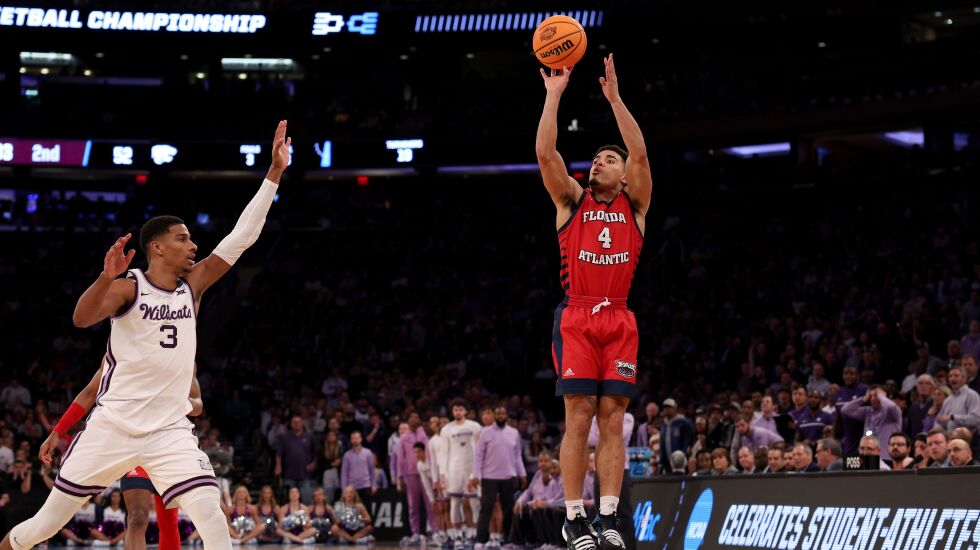
The most important ingredient in any good NCAA Tournament is chaos. The more chaos the better. A rite of March is waiting for the first, distressed cries of people whose brackets are in shambles, usually a day or two into the Big Dance. I imagine it’s what neck-wringing time sounds like on a chicken farm.
No NCAA Tournament has had as much chaos as the current one.
For the first time since 1979, when seeding began, no No. 1, No. 2 or No. 3 seeds made the Final Four. If you had asked me before the tournament began what Florida Atlantic, San Diego State, Miami and Connecticut had in common, I would have said, “What’s a Florida Atlantic?’’ It’s been ridiculously fun.
The tournament isn’t close to what it was years ago in terms of skill. But it has more than made up for it in terms of shock value.
In what used to be a world of haves and have nots, every school now has a chance to be a have.
A huge part of that is the transfer portal, which has added more uncertainty to what was already a crazy, bumpy ride. You can go up and down the rosters of the teams that made the tournament and find transfers everywhere. The impact can’t be overstated.
This was the first Final Four since seeding began that featured no McDonald’s All-Americans. Now, you might weep over the decline in talent that such a shutout would seem to suggest. I love it because it meant no Duke, no Kentucky and no Kansas, the programs that hogged the spotlight for so long that you started to believe that the blue was the official color of the NCAA Tournament.
With the transfer portal, everything’s out in the open – players’ desire to leave their current schools and other schools’ interest in them. OK, the recruiting shenanigans that go on are as hidden as usual, but both sides know who’s available. Thanks to the portal, more players see transferring as a respectable option. An average team can get good very quickly with a couple of transfers who are eager to prove themselves in a new setting.
Kansas State, which lost in the Elite Eight to FAU, had nine players who transferred to play for the Wildcats. Their collaborative success put the lie to the idea of team culture. Kansas State had a new coaching staff and all those new players, yet somehow managed to create togetherness in a matter of months. There was no embedded program “culture’’ to teach them how to behave. They became a team, fast.
Traditionalists might not like the idea of that, but too bad. They probably didn’t like bell bottoms, lava lamps and Twiggy, either. They don’t like NILs (name, likeness and image) because those deals give power to college athletes to earn money. Guess what? Schools have made billions of dollars off kidsfor decades.
What colleges are more likely to benefit most from NILs? The ones with the most money, history and desire to keep the status quo. So, yes, there is a contradiction here: Traditionalists want to see the big-name schools stay good, but the best way for that to happen is through NILs, which allow players to make money through endorsement deals, often set up by wealthy alums or other friends of athletic departments.
The old guard wants the blue bloods to remain blue, and it wants to hold on to the fiction of amateurism, which stipulates that “student-athletes’’ get no green.
All of this is about control. College officials don’t like the transfer portal because they see it as benefiting the individual at the expense of the team. They want the federal government to regulate how athletes can make money through NILs. It’s no surprise that politicians from states where college football is a state religion are in lockstep with the NCAA – even lawmakers from the party that rails against big government.
“The lack of uniformity across different states and institutions has created confusion and uncertainty, and a federal standard is needed so all athletes are playing by the same rules,” Rep. Gus Bilirakis (Fla.-R) said at a recent House committee hearing. “In short, we must strike a delicate balance between the rights of college athletes to profit from their own NIL while keeping the amateur status for all college athletes.”
One translation of that would be, “Hey, my school’s getting outspent on legal recruiting! No fair!!!’’
This year’s NCAA Tournament has been complete madness. I know this because my son-in-law, who knows nothing about college basketball, is one of two people left in the family bracket competition who can win it all. His pick for the national champion was No. 15 seed Vermont, which lost in the first round. It might look like his success has been against all odds, but I know better. He had chaos on his side.
What a beautiful mess this is.







